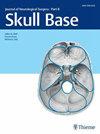症状性非急性颅内大动脉闭塞伴血管内再通的临床研究
IF 0.9
4区 医学
Q3 Medicine
引用次数: 0
摘要
摘要目的本研究报道了一项单中心血管内治疗症状性非急性颅内大动脉闭塞(NA-ILAO)的临床试验。本研究的目的是评价单纯球囊扩张支架植入术的安全性、可行性和临床效果。方法入选诊断为症状性NA-ILAO的患者。本研究共纳入40例。4例患者再通失败,36例患者再通成功,将患者分为球囊扩张组(n = 24)和支架植入组(n = 12)进行进一步分析。分析围手术期并发症、临床结局及随访结果。结果支架置入术组围手术期并发症明显高于单纯球囊扩张组(p <0.05)。球囊组和支架组90天临床预后良好(改良Rankin评分[mRS]≤2)的分别为21例和10例(p = 0.518)。所有成功再通的患者在平均14个月的随访期间接受了数字减影血管造影(DSA)或CT血管造影(CTA)。球囊扩张组2例再狭窄,支架置入组1例再狭窄(p = 1.000)。支架组2例再闭塞,球囊扩张组无再闭塞(p <0.001)。支架组卒中复发2例,单纯球囊扩张组卒中复发1例(p = 0.013)。结论血管内再通术治疗症状性NA-ILAO是安全可行的。与支架植入相比,简单球囊扩张可能是一种更好的再通方法,但需要更大规模的随机对照试验来证实。本文章由计算机程序翻译,如有差异,请以英文原文为准。
Clinical Study of Symptomatic Nonacute Intracranial Large Arterial Occlusion with Endovascular Recanalization
Abstract Objectives This study reported a single-center clinical trial of endovascular treatment for symptomatic nonacute occlusion of the intracranial large artery (NA-ILAO). The aim of this study was to evaluate the safety, feasibility, and clinical effect of simple balloon dilatation and stent implantation. Methods The patients diagnosed with symptomatic NA-ILAO were enrolled. A total of 40 cases were included in this study. While recanalization failed in 4 patients, it was successful in 36 patients, who were then divided into two groups for further analysis: balloon dilatation group (n = 24) and stent implantation group (n = 12). The perioperative complications, clinical outcome, and follow-up results were analyzed. Results Perioperative complications in the stent implantation group were significantly higher than those in the simple balloon dilatation group (p < 0.05). There were 21 and 10 cases of 90-day good clinical outcome (modified Rankin scale [mRS] ≤ 2) in the balloon and stent groups, respectively (p = 0.518). All patients with successful recanalization underwent digital subtraction angiography (DSA) or CT angiography (CTA) during an average follow-up of 14 months. There were two cases of restenosis in the balloon dilatation group and one in the stent implantation group (p = 1.000). There were two cases of re-occlusion in the stent group and none in the balloon dilatation group (p < 0.001). Stroke recurred in two cases in the stent group and in one case in the simple balloon dilatation group (p = 0.013). Conclusion Endovascular recanalization is safe and feasible for patients with symptomatic NA-ILAO. Compared with stent implantation, simple balloon dilation may be a better recanalization method, but larger randomized controlled trials are needed to confirm it.
求助全文
通过发布文献求助,成功后即可免费获取论文全文。
去求助
来源期刊

Journal of Neurological Surgery Part B: Skull Base
CLINICAL NEUROLOGY-SURGERY
CiteScore
2.20
自引率
0.00%
发文量
516
期刊介绍:
The Journal of Neurological Surgery Part B: Skull Base (JNLS B) is a major publication from the world''s leading publisher in neurosurgery. JNLS B currently serves as the official organ of several national and international neurosurgery and skull base societies.
JNLS B is a peer-reviewed journal publishing original research, review articles, and technical notes covering all aspects of neurological surgery. The focus of JNLS B includes microsurgery as well as the latest minimally invasive techniques, such as stereotactic-guided surgery, endoscopy, and endovascular procedures. JNLS B is devoted to the techniques and procedures of skull base surgery.
 求助内容:
求助内容: 应助结果提醒方式:
应助结果提醒方式:


